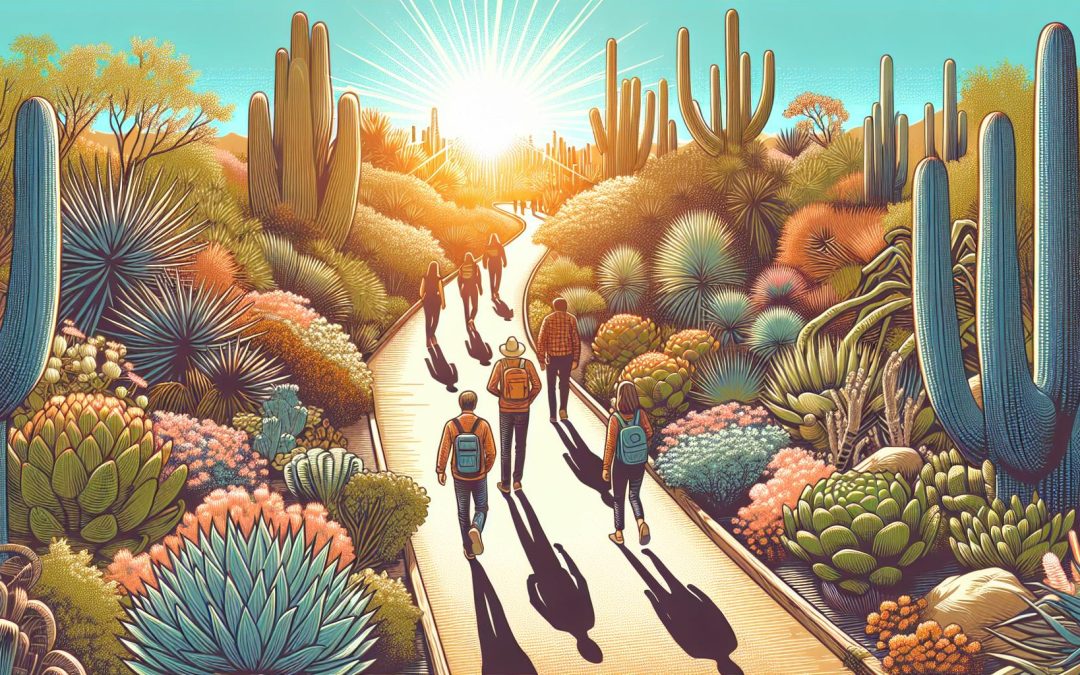I’ve always been fascinated by how life thrives in the harshest conditions. That’s why the Desert Botanical Garden holds a special place in my heart. Nestled in the heart of the desert, it’s a vibrant testament to the resilience and beauty of desert flora.
Walking through its paths, you’re introduced to a world where every plant tells a story of survival and adaptation. It’s not just a garden; it’s a living museum dedicated to the appreciation and preservation of the desert’s natural beauty. Join me as we explore this unique landmark, a sanctuary where the desert truly comes to life.
History of the Desert Botanical Garden
Delving into the rich tapestry of the Desert Botanical Garden’s history, I was struck by its humble beginnings and the vision that propelled it into the renowned sanctuary it is today. It all started in the 1930s when a small group of local citizens, led by Gertrude Divine Webster, a passionate environmentalist, recognized the urgent need to conserve the desert’s beauty and biodiversity. Together, they laid the foundation for what would blossom into one of the world’s most significant collections of desert plants.
In 1939, this dream was materialized on a 140-acre plot of land, graciously allocated by the city, marking the birth of the Desert Botanical Garden. The founders’ mission was clear: to study, to preserve, and to educate. Their dedication was unwavering, and slowly, the garden began to grow, both in size and in its importance to the community and the scientific world.
As I strolled through the garden, I couldn’t help but marvel at how it has flourished over the decades. With more than 50,000 plants displayed across its expanse, the garden now serves as a living museum and a testament to the resilience of desert flora. It’s fascinating to see how it has evolved, adapting to the challenges of conservation while expanding its educational programs to reach a broader audience.
The garden has not only preserved an extensive collection of plants but has also become a hub for research, conservation, and educational programs aimed at understanding and protecting endangered species. Its global reach and efforts to collaborate with other botanical institutions underscore its commitment to environmental stewardship, making it a model for conservation efforts worldwide.
Walking through the Desert Botanical Garden, I’m reminded of the vision and tenacity of its founders. Their legacy continues to inspire not just a deeper appreciation for the beauty and resilience of desert plants but also a commitment to preserving our natural world for future generations.
Unique Flora Found in the Garden

Walking through the Desert Botanical Garden, I’m always struck by the incredible variety of plants that have adapted to thrive in arid conditions. It’s like stepping into a different world, where each plant has its own story of survival and resilience. Among the 50,000 plants, some truly stand out, not just for their beauty, but for their rarity and uniqueness.
One such marvel is the Boojum Tree or Fouquieria columnaris. It’s not just its odd name that catches the eye, but its bizarre, almost Dr. Seussian shape, towering and twisting towards the sky. It’s native to the Baja California Peninsula, and seeing it in person, I’m reminded of the diverse beauty found in desert landscapes.
Another highlight is the Saguaro Cactus (Carnegiea gigantea), the iconic symbol of the American West. Walking past these towering giants, some reaching up to 60 feet tall, it’s hard not to feel awe. Saguaros are not just tall but ancient, with some living up to 200 years. They’re a testament to the enduring nature of desert life, surviving in conditions that would be challenging for most.
Then there’s the Joshua Tree (Yucca brevifolia), which isn’t actually a tree but a species of yucca. It’s a surreal sight, with its spiky leaves and gnarled branches stretching outwards. Native to the Mojave Desert, its presence here in the garden allows visitors to appreciate the unique ecosystems found within deserts.
And let’s not forget the various species of Agave and Aloe, each with their distinctive forms and uses. From the Agave, used to make tequila and mezcal, to the soothing Aloe Vera, it’s fascinating to learn about the practical applications of these plants that go beyond their visual appeal.
Discovering these plants, I’m reminded of the desert’s harsh beauty and the incredible adaptations these species have made to flourish. Each visit brings new insights and a deeper appreciation for the natural world.
Conservation Efforts and Sustainability Practices
One of the Desert Botanical Garden’s core missions is conservation, and I’ve been truly amazed at the lengths they go to preserve desert flora. Their efforts are not only about safeguarding the plants we see today but also ensuring these species thrive for generations to come. They employ a variety of techniques, from seed banking critical species to participating in local and global conservation initiatives. The garden’s commitment to conservation is palpable, with projects that often extend beyond their gates, contributing to global efforts in safeguarding biodiversity.
Sustainability is another key focus at the Desert Botanical Garden. They’ve implemented several practices that minimize their environmental impact and serve as a model for others to follow. For instance, water usage in the garden is highly efficient, utilizing drip irrigation systems and collecting rainwater to ensure that every drop goes a long way in supporting the plants. It’s fascinating to learn how they can maintain such a lush landscape in the desert while being mindful of water scarcity.
Moreover, the garden is committed to educating visitors about sustainability practices they can apply in their own lives. They offer workshops and guided tours that highlight sustainable landscaping techniques, demonstrating how desert plants can be used in beautiful, water-wise gardens at home. These educational efforts not only enrich the visitor experience but also empower the community to embrace sustainability in their daily lives.
By intertwining conservation and sustainability, the Desert Botanical Garden not only protects the unique flora of the desert but also serves as an inspiring example of environmental stewardship. Their work reminds me that every effort, no matter how small, contributes to the larger goal of preserving our natural world.
Events and Activities in the Garden
One of the most delightful aspects of the Desert Botanical Garden that I’ve had the pleasure of experiencing are the myriad events and activities tailored for all ages and interests. From moonlit walkabouts to educational workshops, the garden teems with life and learning opportunities that go far beyond simply admiring local flora.
Seasonal Celebrations are a spectacle to behold. The garden transforms with the seasons, offering unique events that highlight the beauty and traditions of the desert. The Fall Festival celebrates the bounty of the desert, with local produce and crafts taking center stage. Meanwhile, the Winter Solstice event is an enchanting experience, with luminaries lighting up the pathways and live music that fills the crisp evening air.
For those interested in Workshops and Classes, the garden doesn’t disappoint. It offers a variety of programs ranging from botanical photography to plant care. These hands-on sessions not only enhance my understanding and appreciation of desert flora but also equip me with practical skills I can use at home. A particularly fascinating workshop I attended was on sustainable gardening practices, which aligned perfectly with the garden’s ethos of conservation and sustainability.
Art and Culture also find their place amidst the cacti and succulents. The garden regularly hosts art exhibitions, showcasing works that are inspired by or made from natural materials. Live performances, from classical music concerts to contemporary dance shows, are set against the backdrop of the garden, making for unforgettable experiences.
All in all, the range of events and activities at the Desert Botanical Garden ensures that every visit offers something new and exciting to discover. Whether I’m there to learn, celebrate, or simply enjoy the beauty of the desert, I always find something that piques my interest.
Visitor Information and Tips

Planning a visit to the Desert Botanical Garden is an exciting prospect, but there are a few things I’ve learned along the way that might help you make the most out of your adventure. First off, the garden is vast and can take several hours to explore thoroughly, so comfortable footwear is a must. I can’t stress enough how much walking you’ll be doing, and having the right shoes makes all the difference.
The Arizona sun is no joke, especially in the desert environment. I always pack plenty of sunscreen, a hat, and a water bottle to stay protected and hydrated. Luckily, the garden has water refilling stations scattered throughout, so you can easily top off your bottle as you wander through the breathtaking landscapes.
Admission prices and hours vary by season, so it’s wise to check the garden’s official website before planning your trip. Here’s a quick breakdown to get you started:
| Admission Type | Price |
|---|---|
| Adults | $24.95 |
| Seniors (60+) | $22.95 |
| Students (w/ ID) | $12.95 |
| Children (3-17) | $14.95 |
| Members & Children under 3 | Free |
Remember, these prices are subject to change, so it’s a good idea to verify them ahead of time.
To truly absorb the beauty and learn about the desert flora, I recommend taking one of the guided tours offered by the garden. These tours can provide insights and stories you might not discover on your own. Plus, they’re a great way to learn about the conservation efforts and research being done behind the scenes.
Lastly, don’t forget to check the calendar of events before visiting. The garden hosts a variety of activities and exhibits throughout the year – from the dazzling luminaria during the holiday season to the vibrant butterfly exhibit in the spring. Tailoring your visit around these events can make your experience even more memorable.
Conclusion
Visiting the Desert Botanical Garden has been an enlightening experience for me. It’s not just about admiring the beauty of desert plants; it’s about immersing oneself in an environment that thrives under the sun’s relentless gaze. I’ve learned the importance of being prepared – comfortable shoes and sunscreen are your best friends here. And staying hydrated? A breeze, thanks to the conveniently located water stations. If you’re planning a visit, don’t forget to check out their website for the latest on admission fees and event schedules. Trust me, opting for a guided tour can transform your visit into an unforgettable journey through the wonders of desert flora. So, if you’re looking for an adventure that’s both educational and visually stunning, the Desert Botanical Garden should definitely be on your list.







